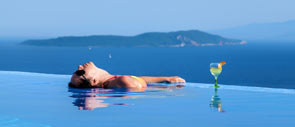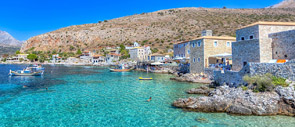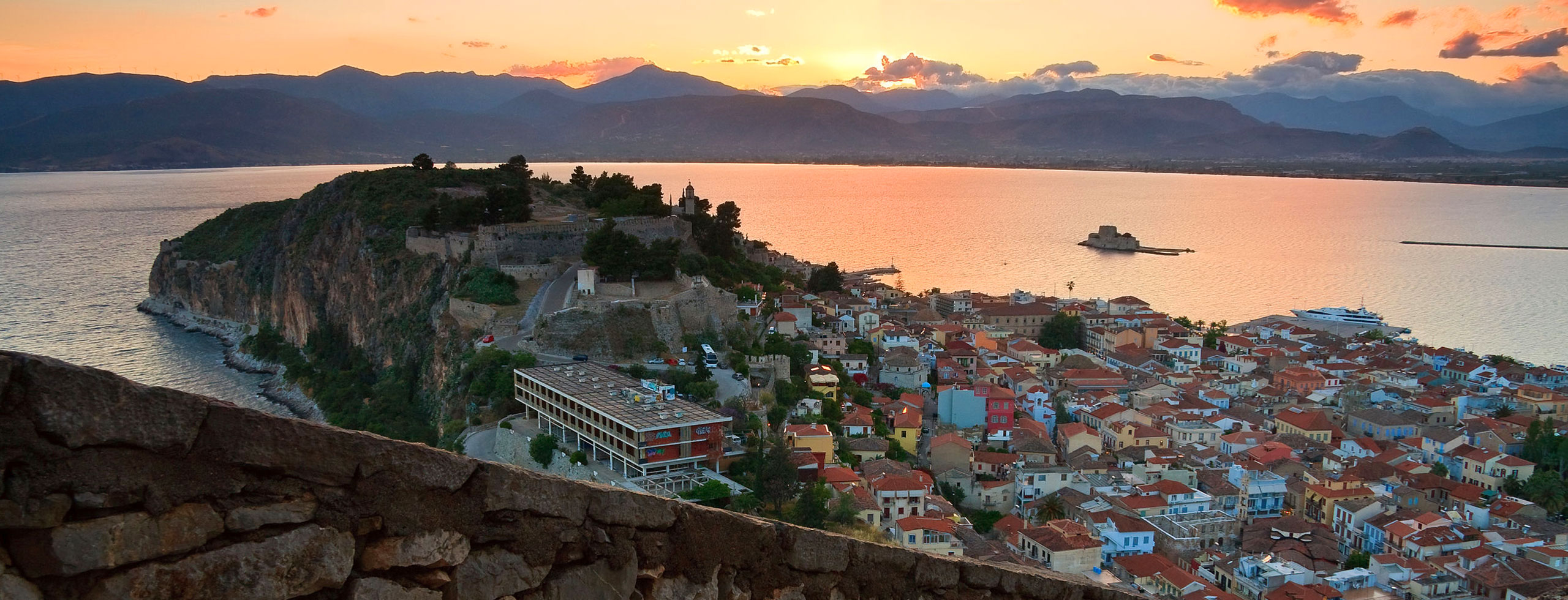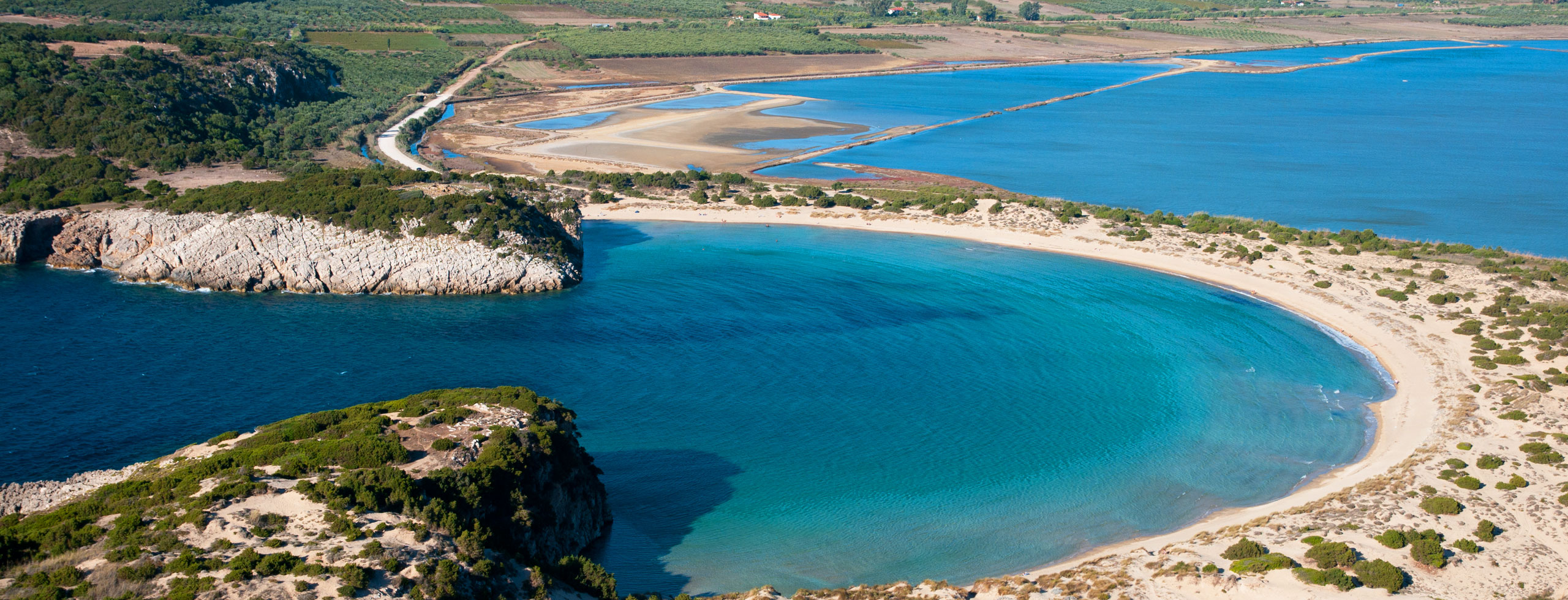Peloponnese Greece - Travel information, Peloponnese hotels, villas, tours, restaurants, beaches, archaeological sites, nightlife
Year in and year out millions of people from all over the world visit Greece and return home glowing and gloating over the wonders the have seen-usually but by no means solely in Athens, Santorini, Delphi, Crete, Mykonos, Rhodes, Patmos and other such highlight destinations. It is understandable that people want to see the major attractions of any country, but with all due respect, there is much more to Greece than these most frequented places. There are cities and sites and regions that hold pleasures and rewards, less well-known to be sure but no less satisfying, and among such in Greece is Messenia, the region occupying the very southwest corner of the Peloponnese. Increasingly drawing more knowledgeable travelers, Messenia offers a variety of attractions ranging from modern luxury resorts to simple seaside restaurants, from ancient archaeological sites to later historical settings, superb sandy beaches and rugged mountain scenery. Travelers willing to venture “outside the box” will surely be enchanted by a visit to Messenia.
General Information
A Greek administrative district traditionally known as a prefecture, Messenia occupies about 1,500 square miles (3,800 square km), an area similar to some US and UK counties. Bordered by the Neda River at the north and the foothills of the Taygetos Mountain along the east, Messenia extends as a peninsula into the Mediterranean between the Ionian Sea to the west and the Gulf of Messenia to the east, ending at Cape Akratas, the southwesternmost tip of Greece. Messenia also extends down along the eastern coast of the Gulf of Messenia into the region known as the Mani. Messenia’s major cities are Kiparissia and Pylos on the northwest coast and Kalamata, the seaport on the northern coast of the Gulf of Messenia.
Anyone hearing the name “Kalamata,” by the way, should at once suspect that olives are one of the chief crops of this region—which is the case, and both the olives and their oil are much prized internationally. Messenia is exceptionally well watered and enjoys a favorable climate, so that these olives along with figs, fruit trees, grain and other agricultural crops have traditionally been the mainstay of Messenia’s population of about 150,000, but in recent years the concentration of people in the larger cities plus the growing tourist infrastructure have changed this pattern.
Messenia as a Tourist Destination
The first waves of tourists were interested primarily in the archaeological and historic sites and since the region lacked attractive accommodations, these people only passed through on day trips. Gradually this changed as around the coast-where in fact most of the region’s population now lives-there emerged a respectable and still growing selection of hotels and restaurants.
In 2010, an even more dramatic development got underway, when one of the most ambitious and luxurious resort hotel/complexes of anyplace in Greece was launched, with golf courses, spas, a conference center, sports and water activities, and a wide selection of accommodations and restaurants. This is the Costa Navarino, a resort complex along the west coast adjacent to the quaint town of Pylos. Aside from its striking facilities, it has gone to the ultimate length to respect the natural environment and promote sustainable tourism.
Not everyone will care for this type of vacation in Greece, but an increasing number of visitors are finding that they can have the best of both worlds-enjoy the finest of comforts and activities while also enjoying the pleasures of Greece’s special environment and history. ?>
Messenia through the Centuries
The ancient region known as Messenia occupied roughly the same area as it does today and for several millennia was inhabited by the non-Greek speaking people of prehistoric Greece-referred to today as “Pelasgians” for lack of anything else to call them! The oldest archaeological site from this era, Malthi, which dated to about 2300 BC, is of no interest to anyone except professionals. When within a few hundred years the first Greek-speaking people, known as the Achaeans, were moving into the Peloponnese, they founded what is more commonly known as the Mycenaean culture, named after their “capital” at Mycenae. By about 1500 BC some Mycenaeans were erecting a palace at Pylos, located near the small town of Hora, some 6 miles inland from the Bay of Navarino. The grand palace these Mycenaeans built there is the one associated with the “wise king Nestor” of Homer’s Iliad. Although this place suffered a major fire about the year 1000 BC, and was allowed to deteriorate, some people did continue to occupy the site.
Very likely these were a new group of Greek-speakers, the Dorians, who had moved into the Peloponnese, displacing the Mycenaeans. Some of these Dorians made Sparta their capital, but other Dorians, led by Cresphontes, established their capital at Stenyclarus on the northern plain of Messenia. These Dorians mixed with the longtime inhabitants of Messenia to become a people known as Messenians, and by the 8th century BC their productive and prosperous land was being eyed by the Spartans. After a series of quarrels and incidents, Sparta invaded Messenia and commenced what is known as the First Messenian War (?743-724 BC). The Spartans emerged as victors and effectively reduced the local Messenians to helots, or little more than slaves. Eventually the Messenians revolted and thus began the Second Messenian war (685-668 BC). Again the Spartans triumphed and some of the Messenians went into exile in Sicily where they established the settlement that would become the great modern city of Messina. In the Third Messenian War (464-455 BC), the Spartans once again triumphed but the Athenians eventually befriended the Messenians and helped some of them establish a settlement at Nafpaktos, which became a prominent city on the northwestern coast of the Gulf of Corinth.
Meanwhile, the Spartans had established a fortress outpost on a rocky promontory on the northern coast of the Bay of Navarino. During the famous Peloponnesian War between Athens and Sparta, the Athenians took over that Spartan fort in 425 BC while the Spartans moved onto the island that practically blocks off the Navarino Bay from the sea. The Athenians, with some help from the Messenians from Nafpaktos, placed the Spartans under siege, and the Spartans eventually surrendered instead of fighting to the last man as had been their reputation. Thucydides gives a graphic account of this famous Battle of Sphakteria, so named after the island. The Spartan prisoners were moved to Athens and used as hostages by the Athenians in negotiating an armistice with Sparta in 421 BC.
Messenia, however, remained under the Spartan yoke, but the Spartans, flush from the final surrender of the Athenians in 404 BC, could not change their belligerent ways. Moving up onto the mainland into the territory controlled by Thebes, the Spartans were defeated in 371 BC at the Battle of Leuctra by the famous Theban commander, Epaminondas. Epaminondas moved on to lead his Theban forces down into the Peloponesse and free many of the peoples there, including the Messenians, from the Spartan masters.
Epaminondas helped the Messenians establish a new capital of Messene in 370 BC, whose people were brought under Roman rule along with most of Greece in 146 BC, after having been involved in various wars involving other Greeks and Macedonians until that time. In the ensuing centuries, Messenia became little more than a backwater territory of the Roman Empire, and when that empire split in AD 395, it became part of the Byzantine Empire ruled from Constantinople. Greeks, Messenians included, were becoming largely a Christian people but they were constantly being attacked and occasionally overrun by barbarian tribes (including Slavs and Avars), Muslims and pirates. This was to change when in 1204 the Western Europeans on their Fourth Crusade captured Constantinople. Mostly Italians and French, they now divided up the Byzantine Empire among themselves, with the French and Flemish—otherwise known as Franks—taking control of most of the Peloponnese. But the Venetians and Genoese were not about to let these Franks have it all their way, and hence caused frequent conflicts. In fact, even before 1204, the powerful Venetian trading fleet had built fortified ports for their ships at Methoni on the west coast of Messenia peninsula and Koroni on its east coast.
After the Ottoman Turks captured Constantinople in 1453, they also eventually captured most of the various regions, towns, and forts of Greece. In the 1680s, as it happens, Messenia was briefly taken back by the Venetians but by 1720 the Turks had regained control and held it until the Greek Revolution that commenced in 1821, which slowly drove out the Turks. Kalamata, in fact, boasts of being the first Greek city to take up arms against the Turks. The final and decisive act of the revolution came in October 20, 1828 when a fleet of some 27 British, French and Russian warships encountered a fleet of Turkish and Egyptian ships inside Navarino Bay. Although the Turko-Egyptian fleet had some 62 ships, they were thoroughly outgunned and outmaneuvered by the allied fleet, and by the end of the day they had lost 33 ships and suffered some 6,000 casualties, while the allies lost no ships and had only some 650 casualties. Although not all Europeans approved of this battle, in fact it effectively climaxed the revolution and forced the Turks to withdraw from Greece in 1829.
Modern Messenia
As a part of the independent nation of Greece, Messenians settled back to their largely agricultural pursuits. Kalamata prospered and grew as the main port for the region’s agricultural products, particularly its olives and figs, which also gave rise to processing plants. It was not until after World War II—during which Messenia like the rest of Greece suffered under the German occupation—that the region’s millennia-old character began to change. Highways and the railroad were upgraded to link Messenia to the rest of Greece, buildings of all kinds were repaired or added, emigrants to North America, Australia and Western Europe sent back money, and gradually foreign tourists began to appear in some numbers.
Messenia ROUTE 1: Pylos and the islands
The modest port town of Pylos can be a pleasant place to spend some hours walking about the streets and then settling into one of the cafes or restaurants in the main square or along the harbor. Without much effort you will spot the lovely “Three Admirals” square in the center of town, which has a memorial to the three admirals who led the British, French, and Russian fleets that destroyed the Turko-Egyptian fleet in the battle in 1828. Arches in the north and south of the square retain the image of the old city, while trees and coffee tables scattered in the shade form an extremely picturesque and appealing setting for relaxing moments of leisure. The beautiful town of Pylos retains its charming old quarter to this day, a setting that is even more enhanced by a fascinating panoramic view of the Bay of Navarino! The town’s small museum does not hold much of great interest; but far more rewarding would be to engage one of the boats prepared to take visitors to Sphakteria island blocking the bay.
On a promontory to the southwest of the town is the massive Neokastro, the New Fort, one of the most impressive and best preserved castles in Greece that was erected by the Ottoman Turks in 1573 and further developed by the Venetians between 1686-1718. Occupying an area of roughly 20 acres located in a small grove of pine trees, it definitely is a worthwhile attraction, especially for history buffs. If you are feeling up to it, you can go up to the Acropolis of Neokastro, formed in a hexagonal shape and with small cells around the big yard that served as the prison it once was. A highlight of Neokastro is the “Stratones Mezonos”, the big rectangular building built by the French General Maison in 1828 and wonderfully restored since then, hosting a unique artistic collection of French journalist, author and philhellene Rene Puaux, who worked in Greece as a war correspondent during the Balkan wars.
Messenia ROUTE 2: Yalova and Paleokastro
Yalova is a very small village beside a sandy beach that is home to some charming seaside tavernas. But the most impressive aspect of Yalova is its beautiful lagoon, the largest lagoon of the region and an extremely fragile ecosystem, situated right next to the village. Linked to the sea by a small channel called Divari—a farm pond during the years of Venetian rule—this fascinating lagoon is a particularly important wetland for migrating birds, but more than anything provides a unique natural environment for long walks or bike rides.
In Yalova, one can observe roughly 270 species of birds, including flamingos, swans, ducks, mallards, eight different species of egrets, stilts, little terns, glossy ibis, or avocets—among other species, but can also find large predators like the eagle, the peregrine falcon, or the osprey. This fascinating ecosystem is also the home of small mammals, such as badgers, hares, or ferrets, as well as Caretta Caretta sea turtles and reptiles. One of the most impressive encounters can be the African chameleon: Yalova is the only place in Europe where this species survives and reproduces!
In addition to birds, mammals, and reptiles, there are roughly 400 animal species around the lagoon. They are very sensitive and shy animals and in addition to their natural enemies, including foxes, weasels, ferrets, cats, and dogs, they are also disturbed by human presence, since many are sadly killed by passing cars, especially during the summer. We kindly ask you to drive slowly around the lagoon and make an effort to preserve this valuable ecosystem.
Since 1998, the management and protection of the Yalova lagoon have been undertaken by the Ornithological Society, which also has the support of various European programs and the cooperation of the corporation that developed Costa Navarino. At the time of publication of this guide, in the summer months the Ornithological Society organized twice weekly eco-tours along two main paths of the lagoon: the “bird-watching path” from the pumping station to the observatory and the “nature trail”, a circular path that gets visitors acquainted with the flora of the region. You may also want to check out the Old Pumping Station— it operates as an information center for the Ornithological Society.
From the small channel of Divari, you can follow the easy path that leads you to the impressive Paleokastro. On the way you will enjoy the stunning scenery of the coast of Sfaktiria and shallow turquoise waters, as well as the legendary crossing of Sikia. The Paleokastro, also known as Paleonavarino, was built by the Franks in the 13th century on the ruins of the ancient citadel, and according to tradition ancient building materials were used for its construction! The completion of the castle fortifications continued by Venetian engineers in the 15th century and its eventual form was finalized by the Ottomans in the 16th century. Once you enter through the gate, you will quite easily climb up to the impressive ramparts with bastions and battlements, from where you can enjoy the amazing view all over the Bay of Pylos, Sfaktiria, Yalova and the Messenian mountains!
A worthwhile activity in that area is taking a walk to the northern part of the castle in order to enjoy the unique Voidokilia beach, which is shaped as three quarters of a perfect circle! Voidokilia is arguably one of the most intriguing beaches in the entire Mediterranean, therefore we definitely recommend a visit to these exotic waters for a swim or your viewing pleasure!
Messenia ROUTE 3: The Palace of Nestor and Ancient Messeni
The Palace of Nestor
A road through the myriads of olive trees leads you to the small town of Hora. Four kilometers to the west of Hora, on the hill of Ano Eglianos, you will find the Palace of famous ancient king Nestor. A complex of several buildings with a total of more than one hundred ground-floor apartments and premises, the Palace consists of four main buildings and some smaller buildings.
This is the “must see” of the region but it has to be admitted that the palace is one of those archaeological sites that impresses less due to the physical remains on the site than by what the visitor brings to the site. Thus, the visitor should arrive knowing that most serious students of the era accept that this was the palace/home of the Nestor who is featured in the Iliad and the Odyssey. For those whose knowledge of Homer is a bit rusty, we remind you that Telemachus, son of Odysseus, came here seeking information from Nestor about his father.
Meanwhile, as a result of his role in these classics, Nestor has entered our language as a synonym for a wise older man. Being present at the home of Nestor, you may realize that he was part of the Mycenaean Greek community that went off to fight the Trojans and thus the remains you see—if not all that impressive per se—are a testimony to the far-reaching Mycenaean realm. The ruins were first excavated in 1939 by an American archaeologist, Carl Blegen, who was interrupted by World War II but took up his excavating from 1952 through 1966; since 1990 other American archaeologists have been carrying on extensive excavations and in-depth studies of the place and its environs.
An interesting fact that adds to the aura of the site is that on the very day he began the excavations, Blegen came across the archives with the first of the 600 tablets since found at Pylos inscribed with Linear B, the writing system that had been known only from Minoan sites on Crete. Although it would be almost 15 years before Linear B was proven to be recording a proto-Greek language, this link would help to also establish that Minoan Crete had been taken over by Mycenaean Greeks.
All this, as stated, is what adds to the resonance of the site, even if you do not choose to identify all the remains as you wander about. For those who do want to know more about the site, the Archaeological Museum in nearby Hora has some finds although the most important are to be seen in the National Archaeological Museum in Athens.
Ancient Messeni
After driving through the Messenian mainland and passing by small villages surrounded by olive trees, you will reach the impressive archaeological site of ancient Messeni, which was founded near the village Mavromati at the western foothills of Mount Ithomi—the strongest natural and artificial fortress of Messinia. Quite a way from Pylos but definitely worth a day-trip excursion, ancient Messeni (not to be confused with Messenia) is one of those archaeological sites that, if it were in any other country than Greece or in any other part of Greece than this remote locale, would probably be far better known and far more frequented. As mentioned above, it is a case of a city/site that was deliberately built from scratch by the victorious Theban general, Epaminondas, who in 370 BC, having defeated the Spartans, decided the Messenians deserved a new capital.
One ancient historian claims that Messeni was built in 85 days, but even if this is probably an exaggeration, the fact is Messeni did get built relatively quickly. Its remains are to this day impressive—although it must be said that much of what one sees today dates from later occupants including the Romans. There are at least six miles of the outer walls with many gateways and towers still intact; remains of a stadium and theater; the sanctuary of Aesclepius, the ancient Greeks’ god of medicine and healing, with its several temples; the Romans’ agora, bath, and stoa; and still more. On the nearby Mount Ithomi are various ancient remains as well as the more recent (but 8th century AD!) Monastery of Voulkano. Quite aside from these, anyone who takes the trouble to drive up to the summit will be rewarded with a truly spectacular view of much of Messenia.
Messenia ROUTE 4: Methoni, Koroni, and Finikounda
These two great fortresses—not much more than 20 miles apart—together or separately bring the visitor directly into the Middle Ages and a world that many are probably a bit vague about. It was the era when the Venetians dominated the trade between Western Europe and the Middle East, and their ships needed ports for repairs, depots for supplies, harbors for refuge from storms and adversaries. During the 12th century the Venetians had established two such rudimentary way stations on the Peloponnese, Methoni on the west coast of Messenia’s peninsula and Koroni on its east coast, and after the Venetians took over much of Greece in 1204 in the aftermath of the Fourth Crusade, they built truly major fortresses at these two locales. Known as “the twin eyes of Venice,” they were not only ports for Venice’s merchant ships and the warships that protected the trade routes, but also became major way stations for the steady stream of Christian pilgrims to the Holy Land. As such, they also became exceedingly prosperous. The Turks captured these fortress towns in 1500 and except for the brief period when the Venetians regained control (1686-1718) held them until 1828.
Methoni—the more impressive and closer to Pylos of the two castle villages—would be a simple, unknown picturesque seaside town in the Peloponnese if it was not built beside a most photogenic castle by the sea, making Methoni one of the most famous destinations in the entire Messenia. The old town of Methoni was once inside the castle, but after its liberation in 1828, it was destroyed to be built outside the castle. The new town was built over a draft of the French General Maison, who conquered Methoni from the Turkish troops. It remains a pretty settlement to this day and definitely deserves a stop to walk its streets right below the beautiful iron balconies and houses with archways, explore the neoclassical squares with palm trees, and take in the feel of the square with the Venetian well and the flower gardens. All the walks around town will arrive at the castle, which for centuries controlled one of the most important passages in the Mediterranean.
As for the Methoni castle itself, after passing the main gate you will walk through the paved road inside the castle, seeing the ruins of houses of the Venetian nobles, the ruins of a Turkish bath, the Byzantine church of Hagia Sophia, parts of Doric columns, and a large monolithic column from granite on top of which stood the winged lion of Venice. Passing through the gate by the sea, you end up at the imposing and most photographed “Bourtzi”, the octagonal last tower of the castle down low at sea level. And if you happen to be here at dawn, you can certainly expect to see one of the most beautiful sunsets in Greece!
Methoni has some beautiful sandy beaches and you will find some more on the way to Finikounda. Around Finikounda, a village established before some 150 years by fishermen (mostly Cretans) and built on sand (!), there are some of the most beautiful, long, crystal-clear beaches of Messenia. Finikounda was once a small seaside fishing village, but has in recent decades developed into a popular summer resort and has therefore lost most of its initial magic. Regardless, it still might be worth a visit if you seek some variety of beach life in the general area.








 View Peloponnese Map
View Peloponnese Map 